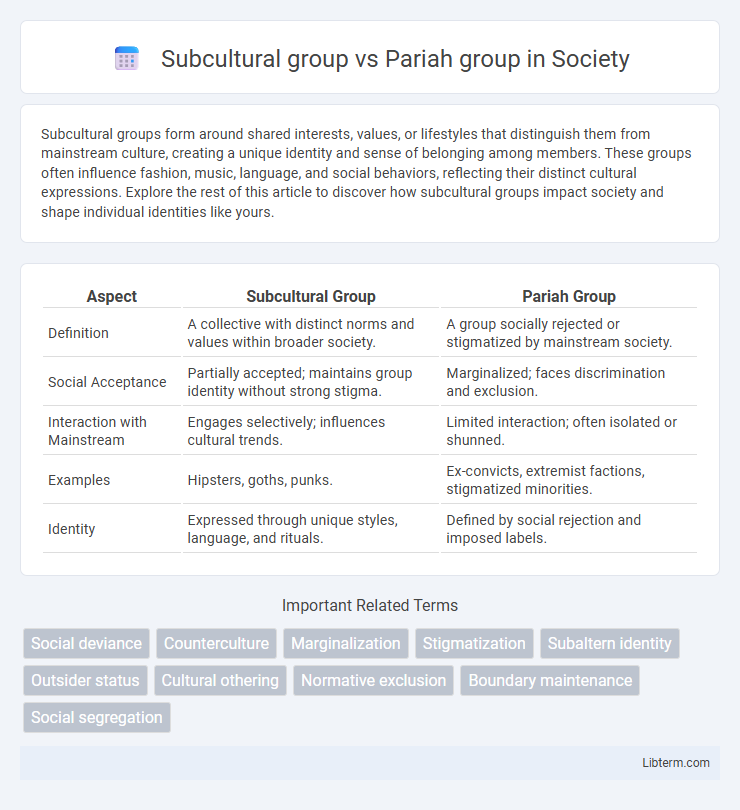Subcultural groups form around shared interests, values, or lifestyles that distinguish them from mainstream culture, creating a unique identity and sense of belonging among members. These groups often influence fashion, music, language, and social behaviors, reflecting their distinct cultural expressions. Explore the rest of this article to discover how subcultural groups impact society and shape individual identities like yours.
Table of Comparison
| Aspect | Subcultural Group | Pariah Group |
|---|---|---|
| Definition | A collective with distinct norms and values within broader society. | A group socially rejected or stigmatized by mainstream society. |
| Social Acceptance | Partially accepted; maintains group identity without strong stigma. | Marginalized; faces discrimination and exclusion. |
| Interaction with Mainstream | Engages selectively; influences cultural trends. | Limited interaction; often isolated or shunned. |
| Examples | Hipsters, goths, punks. | Ex-convicts, extremist factions, stigmatized minorities. |
| Identity | Expressed through unique styles, language, and rituals. | Defined by social rejection and imposed labels. |
Defining Subcultural Groups
Subcultural groups form around shared values, norms, and interests that differentiate them from the dominant culture, often expressing identity through unique styles, language, and behaviors. These groups create a sense of belonging and cohesion by embracing alternative cultural practices that challenge mainstream societal expectations. Unlike pariah groups, subcultural groups engage in socially accepted or neutral activities without facing outright rejection or stigmatization.
Understanding Pariah Groups
Pariah groups are social groups that are rejected or marginalized by the dominant society due to conflicting values, stigmatized behaviors, or perceived threats to social norms, unlike subcultural groups which often coexist with mainstream culture while expressing distinct identities. Understanding pariah groups involves analyzing their social exclusion dynamics, the cultural stigmatization they endure, and the impact of societal rejection on group behavior and identity formation. Research on pariah groups highlights how social prejudice and systemic discrimination shape their marginalization, influencing social cohesion and perpetuating inequalities.
Key Characteristics: Subcultural vs Pariah
Subcultural groups possess distinct norms, values, and behaviors that diverge from mainstream culture but are not necessarily rejected, often fostering a sense of identity and community within society. Pariah groups, in contrast, are marginalized and stigmatized, facing social exclusion and negative labeling due to traits or behaviors deemed deviant or threatening by dominant groups. The key difference lies in social acceptance: subcultures maintain some level of legitimacy, whereas pariah groups are systematically ostracized and denied status.
Origins and Historical Context
Subcultural groups originate as deliberate cultural formations within a larger society, often arising from shared interests, values, or lifestyles that differentiate them from mainstream culture. Pariah groups historically emerge as socially marginalized entities, stigmatized due to perceived deviance or rejection by the dominant social order. The origins of subcultural groups are frequently linked to cultural innovation and identity expression, while pariah groups develop primarily through processes of exclusion and social deviance.
Social Perceptions and Stereotypes
Subcultural groups are often perceived as distinct yet accepted communities with shared values and practices that differ from mainstream culture, while pariah groups face negative social perceptions and are stigmatized or marginalized due to behaviors or attributes considered deviant. Stereotypes surrounding subcultural groups can include assumptions about fashion, interests, and lifestyle choices, whereas pariah groups are typically associated with criminality, immorality, or threat to social order. The social marginalization of pariah groups reinforces exclusion and discrimination, limiting their opportunities for social integration compared to the more tolerated, albeit distinct, status of subcultural groups.
Group Identity and Solidarity
Subcultural groups establish strong group identity and solidarity around shared values, norms, and styles that differentiate them positively from the mainstream culture, fostering internal cohesion and pride. Pariah groups, marked by societal rejection and stigma, develop group identity primarily through collective marginalization, which strengthens solidarity as a defense mechanism against external hostility and exclusion. Both groups rely on internal bonds to maintain cohesion, but subcultural groups often seek positive distinctiveness, while pariah groups often form identities centered on resistance and survival in the face of social condemnation.
Integration vs Marginalization
Subcultural groups maintain distinct values and norms that allow them to integrate within the broader society while expressing unique cultural identities. Pariah groups face exclusion and marginalization due to societal rejection, often stigmatized and denied access to mainstream institutions. Integration characterizes the inclusion of subcultural groups, whereas pariah groups experience marginalization through social isolation and limited participation.
Influence on Mainstream Society
Subcultural groups influence mainstream society by introducing alternative lifestyles, values, and trends that often become absorbed and commodified over time, shaping fashion, music, and social norms. In contrast, pariah groups experience rejection and marginalization due to behaviors or identities considered taboo or threatening, resulting in limited acceptance and minimal mainstream integration. The divergent societal reactions highlight how subcultural groups can drive cultural innovation, while pariah groups remain stigmatized and excluded from dominant cultural narratives.
Stigma, Discrimination, and Social Exclusion
Subcultural groups often maintain distinctive cultural practices without widespread societal rejection, whereas pariah groups face intense stigma, discrimination, and social exclusion due to behaviors considered deviant or threatening by the dominant culture. Stigma attached to pariah groups leads to systemic barriers in employment, education, and social services, reinforcing their marginalization. Social exclusion experienced by pariah groups exacerbates inequalities, isolating members from mainstream social networks and opportunities that subcultural groups may still access.
Comparative Case Studies
Subcultural groups and pariah groups differ primarily in societal acceptance and value systems, with subcultural groups forming identities around distinct norms and practices, while pariah groups face systemic rejection and stigmatization. Comparative case studies reveal that subcultural groups, like goths or hip-hop communities, create positive in-group cohesion despite mainstream marginalization, whereas pariah groups, such as certain marginalized ethnic or religious minorities, encounter persistent exclusion and discrimination. These comparisons highlight the role of power dynamics and cultural capital in shaping group boundaries and social mobility.
Subcultural group Infographic

 libterm.com
libterm.com